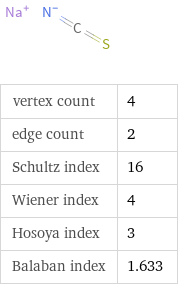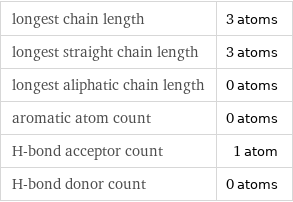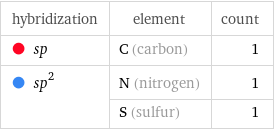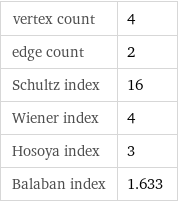Input interpretation

isothiocyanate sodium salt
Basic properties
![molar mass | 81.07 g/mol formula | CNNaS empirical formula | Na_N_C_S_ SMILES identifier | C(=[N-])=S.[Na+] InChI identifier | InChI=1/CNS.Na/c2-1-3;/q-1;+1 InChI key | RROSXLCQOOGZBR-UHFFFAOYSA-N](../image_source/30ef45e3c8bb40f91da8b721ee0b2c8d.png)
molar mass | 81.07 g/mol formula | CNNaS empirical formula | Na_N_C_S_ SMILES identifier | C(=[N-])=S.[Na+] InChI identifier | InChI=1/CNS.Na/c2-1-3;/q-1;+1 InChI key | RROSXLCQOOGZBR-UHFFFAOYSA-N
Structure diagram

vertex count | 4 edge count | 2 Schultz index | 16 Wiener index | 4 Hosoya index | 3 Balaban index | 1.633
Quantitative molecular descriptors

longest chain length | 3 atoms longest straight chain length | 3 atoms longest aliphatic chain length | 0 atoms aromatic atom count | 0 atoms H-bond acceptor count | 1 atom H-bond donor count | 0 atoms
Elemental composition

Find the elemental composition for isothiocyanate sodium salt in terms of the atom and mass percents: atom percent = N_i/N_atoms × 100% mass percent = (N_im_i)/m × 100% Plan: • Write the chemical formula and gather atomic masses from the periodic table. • Determine values for N_i, m_i, N_atoms and m using these items. • Finally, compute the percents and check the results. Write the chemical formula: CNNaS Use the chemical formula to count the number of atoms, N_i, for each element and find the total number of atoms, N_atoms, per molecule: | number of atoms Na (sodium) | 1 N (nitrogen) | 1 C (carbon) | 1 S (sulfur) | 1 N_atoms = 1 + 1 + 1 + 1 = 4 Divide each N_i by N_atoms to calculate atom fractions. Then use the property that atom fractions must sum to one to check the work: | number of atoms | atom fraction Na (sodium) | 1 | 1/4 N (nitrogen) | 1 | 1/4 C (carbon) | 1 | 1/4 S (sulfur) | 1 | 1/4 Check: 1/4 + 1/4 + 1/4 + 1/4 = 1 Compute atom percents using the atom fractions: | number of atoms | atom percent Na (sodium) | 1 | 1/4 × 100% = 25.0% N (nitrogen) | 1 | 1/4 × 100% = 25.0% C (carbon) | 1 | 1/4 × 100% = 25.0% S (sulfur) | 1 | 1/4 × 100% = 25.0% Look up the atomic mass, m_i, in unified atomic mass units, u, for each element in the periodic table: | number of atoms | atom percent | atomic mass/u Na (sodium) | 1 | 25.0% | 22.98976928 N (nitrogen) | 1 | 25.0% | 14.007 C (carbon) | 1 | 25.0% | 12.011 S (sulfur) | 1 | 25.0% | 32.06 Multiply N_i by m_i to compute the mass for each element. Then sum those values to compute the molecular mass, m: | number of atoms | atom percent | atomic mass/u | mass/u Na (sodium) | 1 | 25.0% | 22.98976928 | 1 × 22.98976928 = 22.98976928 N (nitrogen) | 1 | 25.0% | 14.007 | 1 × 14.007 = 14.007 C (carbon) | 1 | 25.0% | 12.011 | 1 × 12.011 = 12.011 S (sulfur) | 1 | 25.0% | 32.06 | 1 × 32.06 = 32.06 m = 22.98976928 u + 14.007 u + 12.011 u + 32.06 u = 81.06776928 u Divide the mass for each element by m to calculate mass fractions. Then use the property that mass fractions must sum to one to check the work: | number of atoms | atom percent | mass fraction Na (sodium) | 1 | 25.0% | 22.98976928/81.06776928 N (nitrogen) | 1 | 25.0% | 14.007/81.06776928 C (carbon) | 1 | 25.0% | 12.011/81.06776928 S (sulfur) | 1 | 25.0% | 32.06/81.06776928 Check: 22.98976928/81.06776928 + 14.007/81.06776928 + 12.011/81.06776928 + 32.06/81.06776928 = 1 Compute mass percents using the mass fractions: Answer: | | | number of atoms | atom percent | mass percent Na (sodium) | 1 | 25.0% | 22.98976928/81.06776928 × 100% = 28.36% N (nitrogen) | 1 | 25.0% | 14.007/81.06776928 × 100% = 17.28% C (carbon) | 1 | 25.0% | 12.011/81.06776928 × 100% = 14.82% S (sulfur) | 1 | 25.0% | 32.06/81.06776928 × 100% = 39.55%
Elemental oxidation states

The first step in finding the oxidation states (or oxidation numbers) in isothiocyanate sodium salt is to draw the structure diagram. Next set every oxidation number equal to the atom's formal charge: There are 1 carbon-nitrogen bond, and 1 carbon-sulfur bond in isothiocyanate sodium salt. For each of these bonds, assign the bonding electrons to the most electronegative element. First examine the carbon-nitrogen bond: element | electronegativity (Pauling scale) | C | 2.55 | N | 3.04 | | | Since nitrogen is more electronegative than carbon, the electrons in this bond will go to nitrogen. Decrease the oxidation number for nitrogen (by 1 for single bonds, 2 for double bonds, and 3 for triple bonds), and increase the oxidation number for carbon accordingly: Next look at the carbon-sulfur bond: element | electronegativity (Pauling scale) | C | 2.55 | S | 2.58 | | | Since sulfur is more electronegative than carbon, the electrons in this bond will go to sulfur: Now summarize the results: Answer: | | oxidation state | element | count -3 | N (nitrogen) | 1 -2 | S (sulfur) | 1 +1 | Na (sodium) | 1 +4 | C (carbon) | 1
Orbital hybridization

hybridization | element | count sp | C (carbon) | 1 sp^2 | N (nitrogen) | 1 | S (sulfur) | 1
Structure diagram

Orbital hybridization Structure diagram
Topological indices

vertex count | 4 edge count | 2 Schultz index | 16 Wiener index | 4 Hosoya index | 3 Balaban index | 1.633